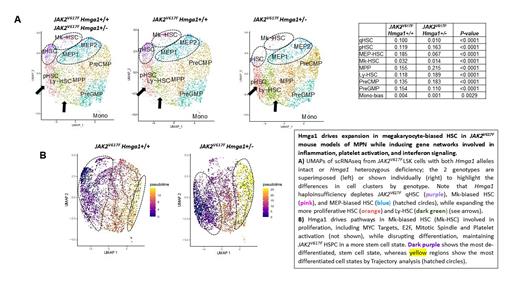Introduction: Myeloproliferative neoplasms (MPN) are clonal hematopoietic stem cell (HSC) disorders characterized by hyperactive JAK/STAT signaling, thromboses, abnormal bleeding, and increased risk of transformation to myelofibrosis (MF) or acute myeloid leukemia (AML). Importantly, clinical outcomes are poor after transformation and actionable mechanisms that drive progression remain elusive. We discovered that High Mobility Group A1 ( HMGA1) chromatin regulators are required for transformation to AML in preclinical models of MPN by up-regulating transcriptional networks involved in GATA2 and proliferation (Li et al, Blood, 2022). Unexpectedly, loss of just a single Hmga1 allele within HSC prevents progression to MF in JAK2 V617F mice. Intriguingly, Hmga1 also drives fibrosis and tumor progression in pancreatic tumor models (Chia et al, JCI 2023). We therefore sought to elucidate mechanisms underlying HMGA1 early in progression that could be targeted in therapy to prevent MF.
Methods : To elucidate Hmga1 function early in MPN, we performed single cell RNA sequencing (scRNAseq) of bone marrow (BM)-derived Lin -, Sca +, c-kit + (LSK) cells from JAK2 V617F mice at 16 weeks old before the development of MF with both Hmga1 alleles intact ( Hmga1+/+) compared to those with haploinsufficiency ( Hmga1+/-). We used gene set enrichment analysis (GSEA) to identify Hmga1-dependent transcriptional networks, CellChat to define cell interactions, and trajectory analysis to assess differentiation. To identify relevant networks in patients, we assessed HMGA1 pathways in transcriptomes from platelets, peripheral blood mononuclear cells, or CD34 + stem and progenitor cells from MPN patients and healthy, age-matched controls via bulk or scRNAseq.
Results: We discovered that loss of just a single Hmga1 allele in HSPC is sufficient to dampen expansion of long-term, quiescent HSC (qHSC), megakaryocyte-biased HSC (Mk-HSC), and megakaryocyte-erythroid-biased HSC (MEP-HSC) while expanding HSC with a lymphoid bias (Ly-HSC) in JAK2 V617Fmice by scRNAseq. Pathway analysis in the most quiescent HSC clusters reveal that Hmga1 induces pathways involved in interferon α (IFNα) and interferon γ (IFNγ) signaling. Trajectory analysis show that JAK2 V617F qHSC with intact Hmga1 have diminished differentiation capacity, leading to decreased Ly-HSC. Because Hmga1 haploinsufficiency dramatically decreased megakaryocyte hyperplasia and thrombocytosis in JAK2 V617Fmice, we focused on HMGA1 transcriptional networks in Mk-HSC and MEP-HSC. Similar to qHSC, Hmga1 up-regulates networks involved in IFNα and IFNγ signaling in Mk- and MEP-biased HSC. In contrast to the qHSC, Hmga1 activates transcriptional networks involved in cell cycle progression in HSC poised to differentiate into Mk and MEP, including: 1) MYC Target pathways, 2) E2F Targets, and, 3) Mitotic Spindle genes. In addition, gene networks involved in oxidative phosphorylation are activated, which associate with proliferative states. Unexpectedly, we also discovered that Hmga1 up-regulates genes involved in coagulation and platelet activation, including genes encoding Platelet factor 4, von Willebrand factor, glycoprotein 2b, glycoprotein 3a, and P-selectin. Because megakaryocytes are associated with inflammatory signals in MPN, we queried inflammatory gene networks, which revealed that Hmga1 induces genes encoding IL6, IL1-β, and gene networks involved in signaling through TNFα and NF-κB. CellChat shows that Hmga1 increases MIF receptor-ligand signaling. Moreover, HMGA1 and similar networks are up-regulated in transcriptomes of platelets, PBMC, and CD34 + cells from patients with JAK2 V617F MPN.
Conclusions: We uncovered a previously unknown epigenetic program in JAK2 V617FMPN whereby Hmga1 induces transcriptional networks that drive expansion in mutant HSC with greatest impact on HSC biased to differentiate into megakaryocytes (Mk-HSC, MEP-HSC). Mechanistically, Hmga1 up-regulates genes involved in cell cycle progression, platelet activation, and inflammatory signaling in Mk-biased HSC. HMGA1 also induces genes involved in IFNα and IFNγ signaling. Together, our studies reveal a new paradigm whereby HMGA1 drives progression early in MPN by activating transcriptional networks required for megakaryocyte expansion, inflammatory signaling, and IFN networks, the latter of which may sensitize JAK2 mutant HSC to IFN therapy.
Disclosures
No relevant conflicts of interest to declare.


This feature is available to Subscribers Only
Sign In or Create an Account Close Modal